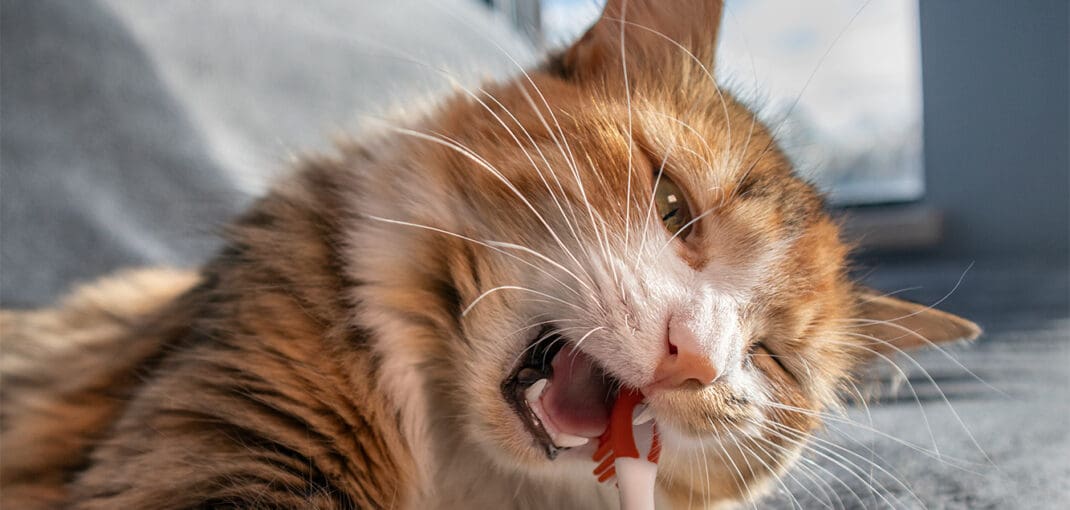Dental complaints are a problem affecting a large group of pet cats. The most common source of trouble is tartar, which becomes the start of a whole cascade of problems. However, certain steps can be taken to spare your cat from such ailments or at least significantly reduce them. To do this, you need to take conscious care of your cat’s teeth.
Where does tartar come from and what is its danger?
Tartar is a mineralised bacterial plaque that builds up every day on the lateral walls of the teeth, mainly at the junction with the gums. When it comes into contact with calcium and magnesium salts present in saliva, but also in the food we eat, it hardens and deposits build up. Tartar begins to encrust the tooth, often leading to further problems such as gingivitis, bleeding in the mouth, soreness during eating and the multiplication of bacteria which have a detrimental effect on the entire organism, including the digestive tract and kidneys. In extreme cases, tartar can lead to the cat losing its teeth.
Unfortunately, it is impossible to say with 100% certainty at what point tartar starts to build up in an individual cat, as this depends on several variables, such as, among others
age – the older the cat is, the more prone it becomes to tartar deposits – this is a matter of statistics,
food intake – cats that are fed a non-human diet have far fewer tartar problems than animals fed commercial foods (especially dry foods). This is probably due to eating a variety of hard animal tissues, which act as a ‘natural toothbrush’ and remove at least some of the plaque from the cat’s teeth on an ongoing basis,
the individual pH of the pet’s saliva – the pH of saliva can change over the course of a cat’s life, hence at some point there may be a stronger tendency to build up tartar.
One thing is certain, however: if tartar appears, it will not disappear by itself.
How do I get rid of tartar from my cat’s teeth?
It should be made clear that tartar can only be removed in one way: during a dental procedure using an ultrasonic scaler. This procedure is carried out under full anaesthetic, before which appropriate blood tests must be carried out and, in the case of cats older than 8 years or those in a risk group, e.g. due to their breed, also a heart echo.
Why is an anaesthetic necessary? Because the procedure itself is unpleasant and a conscious animal will simply not allow the vet to remove all stone deposits, including even subgingival calculus. In addition, it is advisable that the removal of the calculus is accompanied by a dental X-ray to assess the condition of the roots of the teeth, whether there is anything under the gum line (e.g. odontoclastic erosions), whether any tooth is fractured and whether it qualifies for extraction. This is because it is then best to perform all the necessary measures during a single anaesthetic, so as not to put additional strain on the body. Is there another way to effectively remove already mineralised bacterial plaque? No, there isn’t. Neither food nor treats nor any liquids or wipes will remove the tartar. If anyone doubts this, they can take such a treat or a ball of food and try to scrape the limescale off the bathroom tiles with it. I guarantee that there will be no effect and that the result will be identical with cat teeth.
However, specific preventive measures can be taken to prevent the build-up of tartar and this is what you should focus on.
How to prevent tartar formation?
The best way is to brush your cat’s teeth regularly. This is done with special toothpastes and double-headed toothbrushes adapted to the size of the cat’s jaws (size XS or S for large breeds is usually best for cats). A small amount of toothpaste is applied to the toothbrush and it is then run over the upper and lower teeth a few times. Ideally, this should be done every day, but even if the carer does it 1-2 times a week, the effect will still be far better than if oral hygiene is completely abandoned.
If the cat does not allow the use of a toothbrush for cleaning, a special finger pad or simply a gauze pad tightly wrapped around the pad can be used for this purpose. We continue to use paste for cleaning, which is most effective due to its abrasive properties. Alternatively, you can also use special gels or wet wipes soaked in suitable solutions with antimicrobial properties. However, it is important that these products are either tasteless or have a pleasant taste for the pet. Otherwise, the discomfort may be too great and the whole teeth cleaning procedure will cause unnecessary stress. It is particularly important to implement tooth brushing immediately after the tartar removal procedure. This is because it is often observed that tartar builds up quite quickly in cats after such a procedure, so brushing is essential. Especially as bacterial plaque builds up on the tooth as early as 15 minutes after the cleaning is completed, after which it only builds up.
What not to do?
Certainly don’t give dry food to cats to remove tartar, because we already know that this doesn’t work at all. It is important to remember that the particles of dry food, combined with the grease with which many such products are sprayed during the production process, stick to the cat’s teeth, creating a perfect breeding ground for bacteria, which is where the whole problem starts.
Any additives or supplements that alter the pH of saliva – whether in the form of liquids added to water or powder poured into the food – are also not very suitable for cats. In the case of the first solution, it is usually ineffective due to the fact that cats have a species-reduced sense of thirst and drink too little for the preparation to have a real impact. The second option, on the other hand, is usually based on powdered brown algae, which are, among other things, a source of iodine. Iodine, on the other hand, especially when added to the diet regularly, can lead to the development of hyperthyroidism in too high a dose. Cats are species susceptible to this ailment, especially when they enter their senior years. So this type of supplementation is particularly inadvisable in mature and older animals.
Some people also recommend that, in order to combat tartar formation, hard meat treats should be given to cats to chew – whether, for example, pieces of meat on the bone or, for example, long strips of raw or dried meat. This kind of snack can be included in the cat’s diet, but this method is not effective for all cats, so it cannot be relied on as the only form of prevention against this problem.
Summary
Untreated tartar in cats leads to pain and discomfort, can have serious consequences in the cat’s body and can also become the cause of adverse behavioural changes. This is because out-of-trail or aggressive behaviour is often observed in cats suffering from oral problems. Therefore, dental check-ups should be carried out regularly in cats, at least once a year, together with routine blood and urine tests. It is also worth teaching cats to brush their teeth as a normal part of daily care. After all, such regular attention to feline dental hygiene can save your pet a lot of grief in the future.






